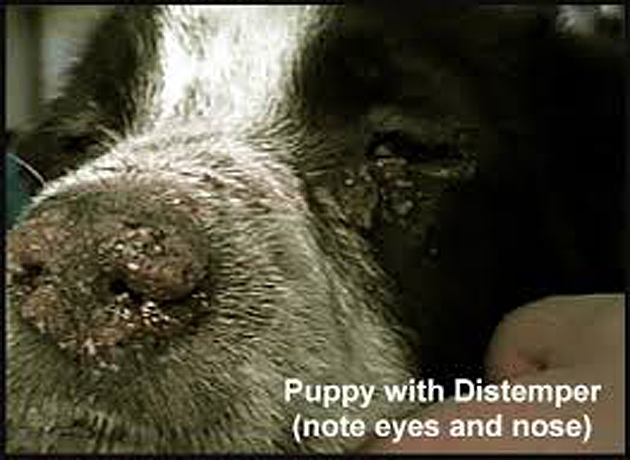Saga Humane Society would like to alert the community of a Canine Distemper Virus (CDV) outbreak in San Mateo. Twenty two cases of distemper have already been seen at the Saga HS clinic. To prevent the spread of this highly contagious disease Saga HS will be doing a Mobile Clinic today, Tuesday, August 6, 2013 to the affected neighborhood and will be vaccinating the area dogs. Vaccines will be at no charge to low income residents or $10 for those who can afford to pay. Saga HS seeks to raise $1000 to buy the vaccinations. This will buy enough vaccinations for 100 animals.
To keep your dog safe make sure it is current on all vaccinations. Contain your dog within your yard and do not allow it to interact with unknown dogs. Puppies from three to six months old are particularly susceptible. CDV spreads through aerosol droplets and through contact with infected bodily fluids, including nasal and ocular secretions, feces, and urine, six to 22 days after exposure.
It can also be spread by food and water contaminated with these fluids. The time between infection and disease is 14 to 18 days, although a fever can appear from three to six days after infection. The virus is destroyed in the environment by routine cleaning with disinfectants, detergents, or drying. It does not survive in the environment for more than a few hours at room temperature (20–25°C), but can survive for a few weeks in shady environments.
Saga HS will keep the public updated on this situation. If you suspect your dog has been exposed to CDV, seek veterinary medical care for your dog immediately.
Distemper in Dogs: Symptoms and Treatments From Pet WebMD
Distemper is a highly contagious disease caused by a virus similar to the one that causes measles in people. Worldwide, it is the leading cause of infectious disease deaths in dogs, all unvaccinated dogs are at high risk of infection.
Infected animals shed canine distemper virus in all body secretions. Inhaling the virus is the primary source of exposure. The highest incidence of the disease occurs in unvaccinated puppies 6 to 12 weeks of age.
Half the dogs that become infected with canine distemper virus show mild signs of illness or no signs at all. The overall health of the dog has a lot to do with how ill he becomes. The disease is most severe in dogs that are poorly nourished and ill-kept.
The distemper virus tends to attack brain cells and cells that line the surfaces of the body, including the skin, the conjunctiva, the mucous membranes of the respiratory tract, and the gastrointestinal tract. The disease takes a variety of forms. Secondary infections and complications are common, partly attributable to the immunosuppressive effects of the virus.
The first signs of distemper appear six to nine days after exposure and in mild cases go unnoticed.
First stage is characterized by a fever spike of up to 103° to 105°F (39.4° to 40.5°C). A second fever spike is accompanied by loss of appetite, listlessness, and a watery discharge from the eyes and nose. These symptoms may be mistaken for a cold.Within a few days, the eye and nasal discharge becomes thick, yellow, and sticky. The dog develops a pronounced dry cough. Pus blisters may appear on the abdomen. Vomiting and diarrhea are frequent and may cause severe dehydration. During the next one to two weeks, very often the dog seems to be getting better but then relapses. This often coincides with the end of the course of antibiotics and the development of gastrointestinal and respiratory complications due to secondary bacterial invasion.
Second stage occurs two to three weeks after the onset of the disease. Many dogs develop signs of brain involvement (encephalitis), characterized by brief attacks of slobbering, head shaking, and chewing movements of the jaws (as if the dog were chewing gum). Epileptic-like seizures may occur, in which the dog runs in circles, falls over, and kicks all four feet wildly. After the convulsive episode the dog appears to be confused, shies away from his owner, wanders about aimlessly, and appears to be blind.
Treatment: Distemper must be treated by a veterinarian. Antibiotics are used to prevent secondary bacterial infections, even though they have no effect on the distemper virus. Supportive treatment includes intravenous fluids to correct dehydration, medications to prevent vomiting and diarrhea, and anticonvulsants and sedatives to control seizures.
The outcome depends on how quickly you seek professional help, the virulence of the distemper strain, the age of the dog, whether he has been vaccinated, and his ability to mount a rapid and effective immune response to the virus. In some cases Euthanasia is the best when the dogs are suffering.
Prevention: Vaccination against canine distemper is almost 100 percent protective. All puppies should be vaccinated by 8 weeks of age. Brood bitches should be given a DHLPPv (distemper, hepatitis, Lepstoporosis, Parvovirus and parainfluenza combination) booster shot two to four weeks before breeding.











